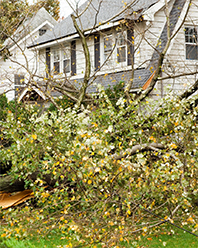Menu
close
Managing property outside of a structure, such as trees, landscaping, turf, hardscapes and irrigation, can be complicated. If disaster strikes, these assets may produce significant losses for a property owner. HMI can advise you on how to identify, manage and mitigate the risk that outdoor assets can present.





Outdoor assets such as trees, water features and hardscapes, can provide a lot of aesthetic value, but they can also constitute a hazard to both people and property.

One of the keys to success in mitigating the impact of a catastrophic event like a hurricane or wildfire is to have a Disaster Preparedness Plan in place.

A property owner must have a good understanding of what assets they have on their property, their value and the risks they pose if they were to fail.

The cost and potential disruption caused by the loss of outdoor assets can be substantial.

HMI provides training to property owners, managers, adjusters, risk managers, legal professionals, government and municipal bodies.

The prevalence of wildfire has increased dramatically over the last 5 years and current trends indicate that the risk of wildfire is only increasing.

Outdoor assets such as trees, water features and hardscapes, can provide a lot of aesthetic value, but they can also constitute a hazard to both people and property. Identifying the hazards that are present outdoors on a property, evaluating the risks presented by these hazards and formulating a plan to diminish the risks that these hazards represent is a critical part of property management. HMI assists its clients in achieving these goals and implementing a best practices approach to the management of outdoor assets. One of the more common hazard assessments that a property can benefit from is a tree risk assessment that can evaluate if a tree is structurally sound or has the potential for failure. Conducting a tree risk assessment demonstrates a property owner’s commitment to managing the risk trees can pose and it can reduce the owner’s liability as well.

One of the keys to success in mitigating the impact of a catastrophic event like a hurricane or wildfire is to have a Disaster Preparedness Plan in place. HMI specializes in creating disaster recovery plans that focus on outdoor assets. Some of the key components of an effective plan include establishing commercial relationships with vendors in order to ensure access to recovery services following a CAT event i.e. tree removal companies; identifying resources for materials i.e. nursery stock, necessary to restore a damaged property; creating protocols for documenting losses of outdoor assets to support insurance claims and more. HMI is able to not only create a Disaster Preparedness Plan but also source vendors, suppliers and subject matter experts that can assist our clients recovering from a loss.

A property owner must have a good understanding of what assets they have on their property, their value and the risks they pose if they were to fail. A property evaluation is different than a hazard assessment in that it provides the property owner with valuable information that will assist them in making decisions regarding insurance coverages, choice of deductible amounts and other organisational measures implemented to control risk. Our experts will evaluate certain characteristics of a property such as number of trees likely to fall in a major event, what topographical features on and near a property can threaten valuable outdoor assets (i.e., a golf course) and what is the value of mature landscaping, to name only a few. Awareness of exposures to outdoor assets is an integral part of any enterprise’s risk management program but they are commonly overlooked – HMI is an expert at identifying them and providing property owners with best practice solutions.

Protecting a property from potential loss exposure is key. Proper maintenance performed consistently is one of the most time and cost-effective ways to prevent loss. The cost and potential disruption caused by the loss of outdoor assets can be substantial. The cost to replace, for example, trees and landscaping that have been destroyed due to pests or diseases may not be covered under an insurance policy, but they are entirely avoidable. Reviewing property maintenance agreements and practices, inspecting irrigation systems, assessing the general health of plant material and performing pre-loss inspections are some of the ways that HMI can assist property owners to prevent loss.

HMI provides training to property owners and managers, adjusters, risk managers, legal professionals and government and municipal bodies. Training can be provided on-line via online seminar or in person. HMI is proud of its continuing education program and we are qualified as CE providers in TX, LA, MS, VA, NC and GA by the departments of insurance in those states. HMI’s training seminars provide valuable tools in the management of outdoor assets and we can customize educational modules to meet the needs of your staff. Some of the most requested educational topics include disaster preparedness plans, how to document losses to outdoor assets such trees, landscaping and golf course features and how to value the replacement cost of mature trees.

The prevalence of wildfire has increased dramatically over the last 5 years and current trends indicate that the risk of wildfire is only increasing. Even areas that did not typically experience wildfires are being impacted. HMI can assist property owners to diminish the risk of catastrophic damage to their property by assessing various environmental and topographical factors that contribute to wildfire exposure and creating a plan to control the risk created by them.